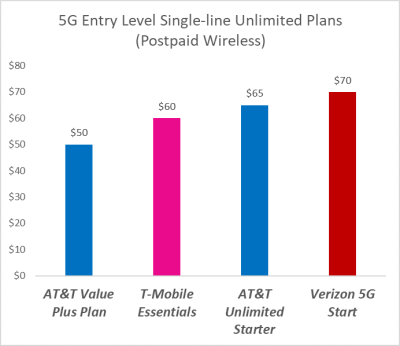AT&T has made a new shift in pricing as it continues to try and grab more segments of consumers – this time with a single-line unlimited 5G postpaid plan that’s significantly cheaper than rivals.
The carrier this month quietly introduced a low-cost unlimited plan that offers 5G access and costs $50 per month for a single line (with discounts for autopay and paperless billing and not including taxes and fees).
The new plan, called Value Plus Plan, undercuts AT&T’s own price on its lowest cost 5G unlimited plan (AT&T Unlimited Starter) where one line is $65 per month. It’s also considerably less expensive than T-Mobile and Verizon’s lowest postpaid offer for a single line with 5G access – a single line on T-Mobile’s Essentials plan is $60 per month, while Verizon’s 5G Start is $70 per month for one line.
On its intro Unlimited Start plan, AT&T also quietly added 3GB of hotspot data, which is the main differentiator from the single-line offer that doesn’t include any hotspot data, noted Corey Chagnon, general manager of Navi, a company that obtains robust daily pricing and promotional data across carriers. The new plan also isn’t eligible for AT&T’s most aggressive trade-in and device deals.
Navi’s consumer-facing service uses big data to collect information on pricing, promotions and plan features, which it displays for users so they can easily compare differences while shopping for wireless service and devices.
“For someone who doesn’t need a new phone, this is a great offer,” Chagnon told Fierce.
Undercutting T-Mobile as price leader
William Ho, principal at 556 Ventures, sees a few rationales for AT&T introducing the new plan.
For one, it “addresses a postpaid lower price point for those that are price sensitive and don’t need the hotspot data" that comes with the Unlimited Start plan, he told Fierce. It also “creates a basic unlimited plan that undercuts competitors by a lot,” Ho said, noting it’s $20 cheaper than Verizon and $10 cheaper than T-Mobile.
“This is significant as this may be one of the first times that T-Mobile is no longer the price/value leader,” Ho said.

T-Mobile historically has taken the lead on offering the lowest prices for plans, while AT&T and Verizon have commanded a premium based on network superiority. However, in the 5G era the claim of best network has become notably more challenged – with T-Mobile staking claim to 5G coverage and speeds.
Postpaid plans in the market often focus on deals for multi-line or family plans, with discounts for additional lines. Asked whether single-line plans could become more of a focus for carriers, Ho noted that a response from rivals and push from AT&T this year may mean there’s a new segment where competition could heat up.
“If we see associated niche marketing in the quarters to come touting AT&T’s price leadership for this plan, price matching and counter-marketing, this suggests that the single line subscriber is a contested segment,” he said.
AT&T goes on all-in with promo strategies
AT&T now has both the cheapest unlimited data offering for single line users, as well as the most aggressive promos on the market, according to Navi.
The lowest cost offer for single line users is also notable in terms of AT&T bringing yet another, albeit niche, segment into the fold for its competitive offers. AT&T has made concerted efforts over the last couple of years to become the most aggressive carrier on promos, including to expand offerings to apply to and attract a wide range of consumers and needs.
As Navi pointed out, AT&T first followed Verizon in providing more flexibility with mix and match unlimited plans in September 2020. A later month it introduced the promotional strategy of expanding its best deals on smartphones to all customers, new and existing, that take unlimited plans rather than just new lines or switchers – one that’s paid off in quarterly subscriber gains and that it’s still using 18 months later. Last June, AT&T extended all device payment plans to 36-month terms, a way to reduce churn and keep customers longer – a move recently adopted by Verizon this February.
The company observed that AT&T in November made changes to extend its most aggressive promotional credit to all tiers of trade-in devices on Galaxy S21 and in February the S22, when it also expanded its list of eligible trade-ins ins.
For the new plan just introduced, aside from prepaid, it’s the first time Navi has seen AT&T focus on a single-line unlimited plan on the lower end of the market.
Granted, there are similarly price prepaid options on the market, but this marks a change for postpaid where consumers in theory get a better network experience.
According to Navi, AT&T already introduced a $50 per month single-line postpaid plan for consumers in 2020 that offered 4GB of LTE data and targeted those not interested in higher cost unlimited plans. With the new Value Plus Plan that data cap is removed and 5G is included for the same price.
At $50 per month for one line, the latest plan is lower ARPU (average revenue per user) than higher tier unlimited plans featuring multiple lines. But a final reason Ho thinks AT&T could be introducing the new plan is that it gives the carrier the opportunity to show off its Unlimited Starter plan’s value features, with the potential to upsell customers to its higher tier unlimited plans.
Stepping up customers into pricier unlimited tiers is one focus of Verizon’s growth strategy outlined at its recent investor day. Verizon expects around 50% of postpaid accounts to be on premium unlimited plans by the end of 2023. AT&T’s investor day is slated for tomorrow, March 11.
